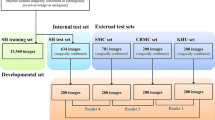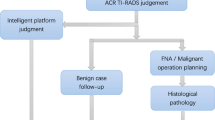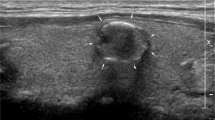Abstract
Objective
An artificial intelligence (AI) algorithm based on convolutional neural networks was used in ultrasound diagnosis in order to evaluate its performance in judging the nature of thyroid nodules and nodule classification.
Methods
A total of 105 patients with thyroid nodules confirmed by surgery or biopsy were retrospectively analyzed. The properties, characteristics, and classification of thyroid nodules were evaluated by sonographers and by AI to obtain combined diagnoses. Receiver operating characteristic curves were generated to evaluate the performance of AI, the sonographer, and their combined effort in diagnosing the nature of thyroid nodules and classifying their characteristics. In the diagnosis of thyroid nodules with solid components, hypoechoic appearance, indistinct borders, Anteroposterior/transverse diameter ratio > 1(A/T > 1), and calcification performed by sonographers and by AI, the properties exhibited statistically significant differences.
Results
Sonographers had a sensitivity of 80.7%, specificity of 73.7%, accuracy of 79.0%, and area under the curve (AUC) of 0.751 in the diagnosis of benign and malignant thyroid nodules. AI had a sensitivity of 84.5%, specificity of 81.0%, accuracy of 84.7%, and AUC of 0.803. The combined AI and sonographer diagnosis had a sensitivity of 92.1%, specificity of 86.3%, accuracy of 91.7%, and AUC of 0.910.
Conclusion
The efficacy of a combined diagnosis for benign and malignant thyroid nodules is higher than that of an AI-based diagnosis alone or a sonographer-based diagnosis alone. The combined diagnosis can reduce unnecessary fine-needle aspiration biopsy procedures and better evaluate the necessity of surgery in clinical practice.
Zusammenfassung
Ziel
Ein Algorithmus der künstlichen Intelligenz (KI) auf der Basis künstlicher (gefalteter) neuronaler Netze wurde in der Ultraschalldiagnostik eingesetzt, um seine Leistungsfähigkeit bei der Beurteilung von Schilddrüsenknoten und der Knotenklassifikation zu untersuchen.
Methoden
Retrospektiv wurden die Daten von 105 Patienten mit chirurgisch oder bioptisch bestätigten Schilddrüsenknoten analysiert. Eigenschaften, Merkmale und Klassifikation der Schilddrüsenknoten wurden von den Ultraschalluntersuchern sowie durch KI beurteilt, um so kombinierte Diagnosen zu erhalten. Mithilfe von ROC(„receiver operating characteristic curves“)-Kurven wurde die Leistungsfähigkeit der KI, der Ultraschalluntersucher und des kombinierten Einsatzes beider ermittelt, die Art der Schilddrüsenknoten und ihrer Klassifizierung zu beurteilen. Bei der durch Ultraschalluntersucher und KI erfolgten Diagnose von Schilddrüsenknoten mit festen Anteilen, echoarmem Erscheinungsbild, unklaren Grenzen, Vorne und hinten/Seitendurchmesserverhältnis > 1 sowie Kalzifizierung wiesen die Eigenschaften statistisch signifikante Unterschiede auf.
Ergebnisse
Bei den Ultraschalluntersuchern betrug die Sensitivität 80,7%, die Spezifität 73,7%, die Genauigkeit 79,0% und die AUC („area under the curve“) 0,751 für die Diagnose benigner und maligner Schilddrüsenknoten. Für die KI lag die Sensitivität bei 84,5%, die Spezifität bei 81,0%, die Genauigkeit bei 84,7% und die AUC bei 0,803. Die Diagnose auf der Grundlage einer Kombination aus KI und Ultraschalluntersuchern wies eine Sensitivität von 92,1%, ein Spezifität von 86,3%, eine Genauigkeit von 91,7% und eine AUC von 0,910 auf.
Schlussfolgerung
Die Verlässlichkeit einer Diagnose benigner und maligner Schilddrüsenknoten auf der Basis einer Kombination aus KI und Ultraschalluntersuchern ist höher als die einer KI-basierten Diagnose allein oder einer alleinigen Diagnose durch Ultraschalluntersucher. Mit einer Diagnose aus der Kombination beider Ansätze können unnötige Feinnadelaspirationsbiopsien vermindert und die Notwendigkeit eines chirurgischen Eingriffs im klinischen Alltag besser beurteilt werden.





Similar content being viewed by others
References
Kim TY, Shong YK (2017) Active surveillance of papillary thyroid microcarcinoma: a mini-review from Korea. Endocrinol Metab 32(4):399–406
Zahir ST, Vakili M, Ghaneei A et al (2016) Ultrasound assistance in differentiating malignant thyroid nodules from benign ones. J Ayub Med Coll Abbottabad 28(4):644–649
Zhang Y, Zhou P, Tian SM et al (2017) Usefulness of combined use of contrast-enhanced ultrasound and TI-RADS classification for the differe ntiation of benign from malignant lesions of thyroid nodules. Eur Radiol 27(4):1527–1536
Mciver B, Hay ID, Giuffrida DF et al (2001) Anaplastic thyroid carcinoma: a 50-year experience at a single institution. Surgery 130(6):1028–1034
Liang XW, Cai YY, Yu JS et al (2019) Update on thyroid ultrasound: a narrative review from diagnostic criteria to artificial intelligence techniques. Chin Med J 132(16):1974–1982
Tessler FN, Middleton WD, Grant EG et al (2017) ACR Thyroid Imaging, Reporting and Data System (TI-RADS): white paper of the ACR TI-RADS committee. J Am Coll Radiol 14(5):587–595
Kermany DS, Goldbaum M, Cai W et al (2018) Identifying medical diagnoses and treatable diseases by image-based deep learning. Cell 172(5):1122–1131.e9
Li X, Zhang S, Zhang Q et al (2019) Diagnosis of thyroid cancer using deep convolutional neural network models applied to sonographic ima ges: a retrospective, multicohort, diagnostic study. Lancet Oncol 20(2):193–201
Song W, Li S, Liu J et al (2019) Multitask cascade convolution neural networks for automatic thyroid nodule detection and recognition. IEEE J Biomed Health Inform 23(3):1215–1224
Choi YJ, Baek JH, Park HS et al (2017) A computer-aided diagnosis system using artificial intelligence for the diagnosis and characterization of thyroid nodules on ultrasound: initial clinical assessment. Thyroid 27(4):546–552
Wang S, Xu J, Tahmasebi A et al (2020) Incorporation of a machine learning algorithm with object detection within the thyroid imaging reporting and data system improves the diagnosis of genetic risk. Front Oncol 10:591846
Thomas J, Haertling T (2020) AIBx, Artificial Intelligence model to risk stratify thyroid nodules. Thyroid 30(6):878–884
Wei X, Zhu J, Zhang H et al (2020) Visual interpretability in computer-assisted diagnosis of thyroid nodules using ultrasound images. Med Sci Monit 26:e927007
Wang J, Jiang J, Zhang D et al (2022) An integrated AI model to improve diagnostic accuracy of ultrasound and output known risk features in suspicious thyroid nodules. Eur Radiol 32(3):2120–2129
Zhang B, Tian J, Pei S et al (2019) Machine learning-assisted system for thyroid nodule diagnosis. Thyroid 29(6):858–867
Wei X, Gao M, Yu R et al (2020) Ensemble deep learning model for multicenter classification of thyroid nodules on ultrasound images. Med Sci Monit 26:e926096
Chambara N, Ying M (2019) The diagnostic efficiency of ultrasound computer-aided diagnosis in differentiating thyroid nodules: a systematic review and narrative synthesis. Cancers 11(11):1759
Zhang T, Li F, Mu J, Liu J, al Zhet (2017) Multivariate evaluation of Thyroid Imaging Reporting and Data System (TI-RADS) in diagnosis malignant thyroid nodule: application to PCA and PLS-DA analysis. Int J Clin Oncol 22(3):448–454
Gong T, Wang J (2012) The analysis of the calcification in differentiating malignant thyroid neoplasm and the molecular me chanisms for the formation of the calcification. Lin Chung Er Bi Yan Hou Tou Jing Wai Ke Za Zhi 26(16):763–766
Frates MC, Benson CB, Charboneau JW et al (2006) Management of thyroid nodules detected at US: Society of Radiologists in Ultrasound consensus confere nce statement. Ultrasound Q 22(4):231–238 (discussion 9–40)
Su JJ, Hui LZ, Xi CJ, Su GQ (2015) Correlation analysis of ultrasonic characteristics, pathological type, and molecular markers of thyroid nodules. Genet Mol Res 14(1):9–20
Moon HJ, Kwak JY, Kim EK, Kim MJ (2011) A taller-than-wide shape in thyroid nodules in transverse and longitudinal ultrasonographic planes and the prediction of malignancy. Thyroid 21(11):1249–1253
Zhang S, Zhao J, Xin XJ et al (2013) Diagnostic value of thyroid microcarcinoma with a taller-than-wide shape in thyroid nodules. Zhonghua Yi Xue Za Zhi 93(40):3223–3225
Desser TS, Kamaya A (2008) Ultrasound of thyroid nodules. Neuroimaging Clin N Am 18(3):463–478
Yao S, Yan J, Wu M et al (2020) Texture synthesis based thyroid nodule detection from medical ultrasound images: interpreting and sup pressing the adversarial effect of in-place manual annotation. Front Bioeng Biotechnol 8:599
Akkus Z, Cai J, Boonrod A et al (2019) A survey of deep-learning applications in ultrasound: artificial intelligence-powered ultrasound for improving clinical workflow. J Am Coll Radiol 16(9 Pt B):1318–1328
Funding
Yunnan Province “Ten thousand people plan” famous doctor special (certificate number: YNWR-MY-2018-004).
Author information
Authors and Affiliations
Contributions
Aitao Yin and Yongping Lu designed the research study, Fei Xu analyzed the data, Yifan Zhao, Yue Sun, Miao Huang, and Xiangbi Li wrote the paper.
Corresponding author
Ethics declarations
Conflict of interest
A. Yin, Y. Lu, F. Xu, Y. Zhao, Y. Sun, M. Huang and X. Li declare that they have no competing interests.
All studies mentioned were in accordance with the ethical standards indicated in each case. This retrospective study was performed after consultation with the institutional ethics committee (Institutional Review Committee of the Affiliated Hospital of Yunnan University (approval number: 2021082)) and in accordance with national legal requirements. All patients were exempted from providing informed consent.
The supplement containing this article is not sponsored by industry.
Additional information
The authors AiTao Yin and Fei Xu contributed equally to this study.

Scan QR code & read article online
Rights and permissions
About this article
Cite this article
Yin, A., Lu, Y., Xu, F. et al. Study on diagnosis of thyroid nodules based on convolutional neural network. Radiologie 63 (Suppl 2), 64–72 (2023). https://doi.org/10.1007/s00117-023-01137-4
Accepted:
Published:
Issue Date:
DOI: https://doi.org/10.1007/s00117-023-01137-4




